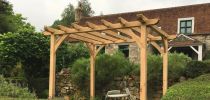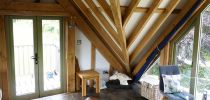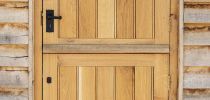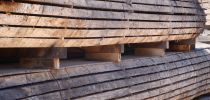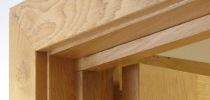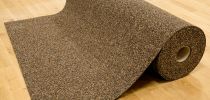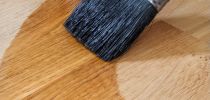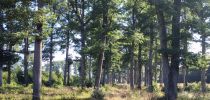

Joinery
Understanding moisture in oak
Learn about the relationship between moisture content and movement in oak.
16th May 2023
Similar to all living organisms, trees exist in a state of moisture imbalance with their surroundings and have a constant requirement to absorb water through their roots. The moisture level in a timber sample is determined by the ratio of water present to the weight of the wood when it is dry.
When freshly cut, the heartwood of an oak tree can contain up to 80% moisture, while the sapwood and branches may have even higher levels. The cell walls are fully saturated, and any remaining water is held in the cell cavities.
What happens when a tree is felled?
Upon being felled, the tree’s growth stops, and the trunk begins to lose moisture from its surface. Initially, the “free” water in the cell cavities evaporates until a point is reached where the cell cavities become empty, but the cell walls remain saturated. This moisture level is referred to as the fibre saturation point (FSP), which is approximately 30% for oak but may slightly vary between species.
As the moisture content continues to decrease, the cell walls gradually lose moisture, resulting in a proportional shrinkage across their width. This shrinkage rate, starting from the FSP to complete dryness, is approximately linear. Eventually, under a specific air relative humidity, the moisture content stabilises at a value known as the equilibrium moisture content, known as EMC.
When does the moisture content stabilise?
In an internally heated environment with a relative humidity of around 40-50%, the moisture content of oak will eventually stabilise at 7-10%. In a protected, unheated environment with a relative humidity of 50%-85%, the EMC will be approximately 12-14%. However, timber exposed directly to sun and rain will naturally experience fluctuating moisture content, ranging from 12% to over 20%, especially in the outer layers that are subject to direct wetting and drying.
This drying process causes the timber to shrink, but the anisotropic (directionally dependent) structure of the wood leads to different effects in three directions. Along the grain, which is stabilized by 95% of the cells, the total shrinkage for all species from green (freshly cut) to completely dry is negligible and can be disregarded for practical purposes. For oak, the radial shrinkage (perpendicular to the growth rings) from green to 10% moisture content, partially stabilised by rays, is approximately 4.5%, while the corresponding tangential shrinkage (across the growth rings with no stabilising cells) is around 7%. These shrinkage movements are notably higher than those observed in most common softwoods.
How does this affect the timber?
The impact of this shrinkage on a specific piece of oak depends on its dimensions and position within the log. To predict distortion accurately, it is helpful to envision the growth rings straightening out as the piece dries, however, the shrinkage will never be uniform in all directions. This non-uniform behaviour is due to the structure of wood and the arrangement of its cells. The two primary directions of interest when discussing wood shrinkage are the tangential and radial directions.
Tangential Shrinkage
- The tangential direction is across the growth rings of the tree, perpendicular to the radial direction.
- When wood loses moisture and dries out, it tends to shrink more significantly in the tangential direction compared to the radial direction.
- Tangential shrinkage can lead to the wood developing cracks, splits, and warping. This is because the wood fibers in the tangential direction are interconnected and aligned in a way that promotes greater movement in response to moisture changes.
Radial Shrinkage
- The radial direction runs along the growth rings of the tree, from the center of the tree outwards.
- Radial shrinkage is generally less pronounced than tangential shrinkage. Wood contracts less along the radial direction because the cell structure is designed to be more stable in this orientation.
- While there is still some dimensional change in the radial direction, it is not as extreme as in the tangential direction.
It's important to note that the longitudinal direction (along the length of the tree) experiences very little shrinkage as wood cells are elongated in this direction and are therefore less affected by moisture changes.
Understanding the relationship between moisture content and movement is crucial for effectively working with oak. By considering various factors such as acclimation, monitoring moisture content, appropriate storage, conditioning, design, and finishing, it is possible to minimise the potential adverse effects of moisture-related movement, ensuring the longevity and performance of projects involving oak.





